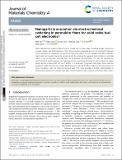Files in this item
Nanoparticle exsolution via electrochemical switching in perovskite fibers for solid oxide fuel cell electrodes
Item metadata
| dc.contributor.author | Xu, Min | |
| dc.contributor.author | Cao, Ran | |
| dc.contributor.author | Wu, Shitao | |
| dc.contributor.author | Lee, JinGoo | |
| dc.contributor.author | Chen, Di | |
| dc.contributor.author | Irvine, John T. S. | |
| dc.date.accessioned | 2023-04-19T09:30:11Z | |
| dc.date.available | 2023-04-19T09:30:11Z | |
| dc.date.issued | 2023-06-28 | |
| dc.identifier | 284258025 | |
| dc.identifier | a3af3702-41d4-4c2f-a0ef-bb9f972eacd0 | |
| dc.identifier | 85153173831 | |
| dc.identifier.citation | Xu , M , Cao , R , Wu , S , Lee , J , Chen , D & Irvine , J T S 2023 , ' Nanoparticle exsolution via electrochemical switching in perovskite fibers for solid oxide fuel cell electrodes ' , Journal of Materials Chemistry A , vol. 11 , no. 24 , pp. 13007-13015 . https://doi.org/10.1039/d3ta00535f | en |
| dc.identifier.issn | 2050-7488 | |
| dc.identifier.other | Jisc: 1025943 | |
| dc.identifier.other | publisher-id: d3ta00535f | |
| dc.identifier.other | ORCID: /0000-0002-8394-3359/work/133727424 | |
| dc.identifier.uri | https://hdl.handle.net/10023/27431 | |
| dc.description | Funding: The authors thank the National Key Research and Development Program of China (no. 2021YFA0718900). They also thank the EPSRC for a Critical Mass project EP/R023522/1 and Electron Microscopy provision EP/R023751/1, EP/L017008/1; they also appreciate the support from National Research Foundation of Korea (NRF) grant funded by Korea government (MSIT) (no. 2021R1A2C2092130). Min acknowledges support from China Scholarship Council (no. 201706070126). | en |
| dc.description.abstract | Metal nanoparticles support materials play a crucial role in many fields, including energy conversion/storage, catalysis and photochemistry. Here, the exsolution is reported as an in situ method to fabricate metal nanoparticles supported on perovskite (La0.52Ca0.28Ni0.06Ti0.94O3) powder and fiber materials. Significantly decreased polarisation resistance can be achieved by applying electrochemical switching within 3 min on the fiber electrode fuel cell to facilitate the exsolution. The fuel cell activated by electrochemical switching under wet hydrogen shows a promising performance with a maximum output power density of about 380 mW cm−2 at 900 °C in hydrogen. The phase-field model shows that the exsolution under extreme low oxygen partial pressure induced by electrochemical switching performs faster nucleation than the chemical-reduced case. This work provides a further understanding of electrochemically driven exsolution with fiber structure platform and simulation with phase-field models. | |
| dc.format.extent | 9 | |
| dc.format.extent | 1420948 | |
| dc.language.iso | eng | |
| dc.relation.ispartof | Journal of Materials Chemistry A | en |
| dc.subject | QC Physics | en |
| dc.subject | QD Chemistry | en |
| dc.subject | NDAS | en |
| dc.subject | MCC | en |
| dc.subject.lcc | QC | en |
| dc.subject.lcc | QD | en |
| dc.title | Nanoparticle exsolution via electrochemical switching in perovskite fibers for solid oxide fuel cell electrodes | en |
| dc.type | Journal article | en |
| dc.contributor.sponsor | EPSRC | en |
| dc.contributor.sponsor | EPSRC | en |
| dc.contributor.sponsor | EPSRC | en |
| dc.contributor.institution | University of St Andrews. School of Chemistry | en |
| dc.contributor.institution | University of St Andrews. Centre for Energy Ethics | en |
| dc.contributor.institution | University of St Andrews. Centre for Designer Quantum Materials | en |
| dc.contributor.institution | University of St Andrews. EaSTCHEM | en |
| dc.identifier.doi | https://doi.org/10.1039/d3ta00535f | |
| dc.description.status | Peer reviewed | en |
| dc.identifier.grantnumber | EP/R023522/1 | en |
| dc.identifier.grantnumber | EP/R023751/1 | en |
| dc.identifier.grantnumber | ep/l017008/1 | en |
This item appears in the following Collection(s)
Items in the St Andrews Research Repository are protected by copyright, with all rights reserved, unless otherwise indicated.

